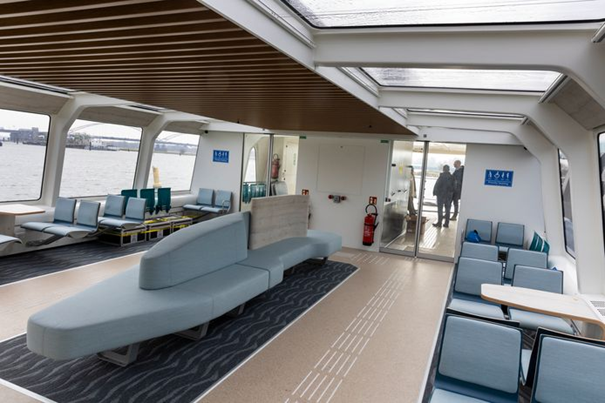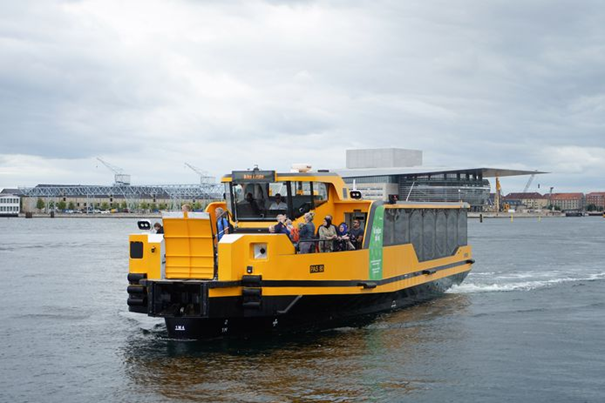It may have taken some time, but the first electric water bus – the Blue Hamburg – has been sailing in the Rijnmond region since this week. The rest of the fleet will follow during the forthcoming months. The AD took a Het AD nam een kijkje in de trots van scheepsbouwer Damen Shipyards. Antti Liukku 06-07-23, 07:59
Welcome to the balcony, as Waterbus Director Gerbrand Schutten refers to it. “Just look at all that space! Much more contact with the water. And that’s exactly what our travellers want.”
He’s stood on the aft deck of one of the new – partly – electric water buses in the Schokhaven in Zwijndrecht, where the transporter’s office is located. The new fleet’s ‘test phase’ took a little longer than expected, but one by one the ships will start sailing from this week onwards. Electric catamarans, now that’s a first. These don’t actually sail with the Blue Amigo logo, as described earlier, but simply under the ‘Waterbus’ name.
More space for cyclists
So what does this new generation of ships actually look like? Firstly, the aft deck has definitely been subjected to some significant changes. For starters, it’s much larger than the old water buses. “This was one particular area we regularly received comments about. Many people like to enjoy the boat trip from the aft deck, but there really wasn’t sufficient room for that.” The aft deck now features benches where travellers can sit down and relax. There’s also more space for cyclists, with charging points.
The new-style water bus has been designed with different target groups in mind: commuters, day trippers, cyclists, parents with children. After all, there’s no such thing as an average traveller, according to Schutten. “We’ve now moved away from the ‘airplane setup’. Research has shown that people generally look for some variation in sitting and standing options.”

Laptop
There’s a large, ‘lounge-like’ sofa in the centre. “A lovely place to sit down and relax with, for example, a pram or possibly a large bag of shopping. All of this has contributed to everything now being a great deal more informal.” There are also various places to sit on the side, perfect for commuters who want to get a bit of work done on their laptops.
A variety of different target groups have been taken into account this time around: wheelchair-accessible toilets, floor markings for the visually impaired and wall shelves for parents who want to change their children. Another thing Schutten was keen to mention: the windows are much larger than before, glass has even been included in the roof. “A panoramic view. This serves to make it a much greater experience.”

Copenhagen
The new fleet consists of nine water buses; three fully electric ships will be sailing between the Drechtsteden. The fleet also boasts six hybrid ships for the longer connection between Rotterdam and Dordrecht, as the battery isn’t capable of covering this distance as yet.
These ships are actually a follow-up to the ‘Copenhagen series’. You can already find Damen’s electric ferries sailing in the Danish capital. However, there are a number of important differences. The Copenhagen ships have a large plug at the front, a ‘head charger’ which is automatically pushed into a charging station when the ferry docks with its front facing a stop.

Catamarans
However, this charging solution isn’t suitable for the Rijnmond. The current is stronger here, plus the waterways are much busier too. This means the water bus needs to moor alongside. “We sail straight into the quay in Copenhagen, which is a fairly simple operation. But we sail alongside with our catamarans here and subsequently plug in,” Schutten says. There’s a large charging station at Papendrecht too (costs: 1.5 million euros) where the ships can be charged for a longer period of time.
This series is therefore going to be adapted in line with the Rijnmond’s specific circumstances. “I can’t wait for these to be ready to sail. It’s truly going to be a huge leap forward,” says Schutten.

Source: AD/Dit zijn ze dan: de langverwachte elektrische nieuwe waterbussen